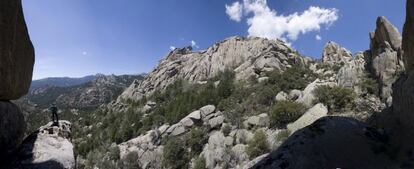A 100-year wait for a new national park
Guadarrama to finally get official status after original request in the 1920s Ecologists voice concerns over three different sites of natural interest

The National Park network in Spain is growing. On Friday, the Cabinet approved a draft law to create the National Park of the Summits of Guadarrama, located between Segovia province and the Madrid region. It will, announced Deputy Prime Minister Soraya Sáenz de Santamaría, be the 15th on the list and the fifth largest.
Soraya added that the decision to create a national park in Guadarrama, located north of the capital, satisfies a request made as far back as the 1920s. "We nearly waited 100 years, but all's well that ends well," she joked.
However, some controversy remains: while creating the park, the government has accepted all the conditions set by the regional authorities of Castilla y León and Madrid, which means that several relevant green spots are being left out and that the door is open to the possibility of expanding existing ski stations in the area.
Madrid premier Esperanza Aguirre called it "extraordinary news," and said that her government has been "fighting for many years" for this result, according to news agency Europa Press. The draft approved on Friday, which will later be sent to Congress, describes a total area of 33,664 hectares, of which 21,740 are in Madrid and the rest in Castilla y León.
Its demolition only followed political criteria, excluding private land"
Santamaría said that the law will incorporate something new: "The possibility of declaring a state of emergency" in a national park in the event of an environmental disaster. This measure is being adopted after recent wildfires, where many reported a lack of coordination among the various emergency services.
In Guadarrama, the president of the national parks agency will be able to declare a state of emergency if there is an environmental disaster caused by a wildfire or any other extraordinary cause. The goal is to prevent irreparable damage to the park when regular coordination mechanisms fail.
When Miguel Arias Cañete took over the Agriculture, Food and Environment Ministry portfolio, he admitted that he did not know much about this latter issue. Before long he announced that one of his priorities would be to underscore the value of national parks. Although the parks are run by regional governments (due to a controversial 2004 decision by the Constitutional Court), it is the ministry that coordinates them, and the central government that creates them through law. Guadarrama is the first national park to be created in five years, following the opening of Monfragüe in Cáceres. Yet the paperwork began 10 years ago. The project was held up by countless alterations and delays; the previous Socialist administration was unconvinced because the proposed park limits bypassed ski stations and even mineral springs where bottled water is produced.
The park encompasses three spaces that were declared Natural Sites of National Interest in 1927: La Pedriza del Manzanares; the Summit, Cirque and Lagoons of Peñalara; and the Pine Grove of Acebeda. The resulting area is always upwards of 1,600 meters in altitude, which means many protected animal species are not included. Around 46 percent of the park surface is covered with "high altitude scrubland, pastures, woody steppes and kermes oak groves," while 29 percent are pine and juniper groves.
The environmental group Ecologists in Action is criticizing the park design because "its delimitation only followed political criteria, including public land and almost completely excluding private land."
"Areas of scant value such as the pine groves of Navarredonda are included but not the high river basin of the Lozoya, which is home to the largest cinereous vulture community in the entire Madrid region," the group says. The new law also permits using the park for "incompatible and insufficiently justified" events such as cycling races.
Tu suscripción se está usando en otro dispositivo
¿Quieres añadir otro usuario a tu suscripción?
Si continúas leyendo en este dispositivo, no se podrá leer en el otro.
FlechaTu suscripción se está usando en otro dispositivo y solo puedes acceder a EL PAÍS desde un dispositivo a la vez.
Si quieres compartir tu cuenta, cambia tu suscripción a la modalidad Premium, así podrás añadir otro usuario. Cada uno accederá con su propia cuenta de email, lo que os permitirá personalizar vuestra experiencia en EL PAÍS.
¿Tienes una suscripción de empresa? Accede aquí para contratar más cuentas.
En el caso de no saber quién está usando tu cuenta, te recomendamos cambiar tu contraseña aquí.
Si decides continuar compartiendo tu cuenta, este mensaje se mostrará en tu dispositivo y en el de la otra persona que está usando tu cuenta de forma indefinida, afectando a tu experiencia de lectura. Puedes consultar aquí los términos y condiciones de la suscripción digital.
Últimas noticias
The brief rise and retreat of Generation Z in Mexico
A floating school teaches children how to save Lake Atitlán
Pablo Escobar’s hippos: A serious environmental problem, 40 years on
From Andorra to Gibraltar, a black market for Ozempic exploits its success: ‘They’re the most sought-after products in the world’
Most viewed
- Why we lost the habit of sleeping in two segments and how that changed our sense of time
- Charles Dubouloz, mountaineering star, retires at 36 with a farewell tour inspired by Walter Bonatti
- Venezuela faces its most tense Christmas yet
- Trump’s obsession with putting his name on everything is unprecedented in the United States
- CBS in crisis after pulling a report on Trump’s deportations to El Salvador (which later leaked online)








































